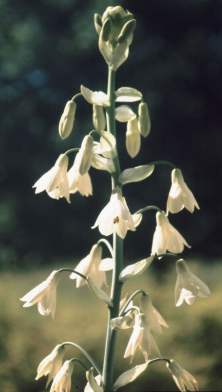Ornithogalum candicans
Ornithogalum candicans (Baker) J.C.Manning & Goldblatt (=Galtonia candicans (Baker) Decne.)
Family: Hyacinthaceae
Common names: berg lily, summer hyacinth, Cape hyacinth (Eng.); berglelie, Kaapse hiasint (Afr.); isidwa esimhlope (Zulu)
Introduction
The summer hyacinth, with its fragrant bell-shaped flowers, is an ideal accent plant in a mixed bed and is also very suitable for cut flowers. It was previously known as Galtonia candicans.

Description
Description
This bulbous species is winter-dormant and produces erect, strap-shaped leaves of up to 1.5 m long in spring. It flowers in summer (December to February) and the sturdy inflorescences (racemes) may grow up to 1.25 m long. The rather large flowers (up to 30 mm long) are pendant, bell-shaped, fragrant and long lasting. They are mostly pure white, but the tube is sometimes pale green on the outside with a very pale green median band running up the back of each lobe.
Conservation Status
Status
Ornithogalum candicans is not threatened.
Distribution and habitat
Distribution description
Ornithogalum candicans grows on the slopes of the Drakensberg in Mpumalanga, Free State, KwaZulu-Natal, Lesotho and the Eastern Cape at altitudes of 1350-2150 m. It prefers open, damp grassland and is often found in grassy hollows on hill slopes. Since the bulbs are dormant in winter, they are extremely frost hardy and are ideal for areas with high summer rain and cold, dry winters.
Derivation of name and historical aspects
History
This species was discovered by Thomas Cooper at the side of a stream in the foothills of the De Beer's Pass, northeast of the better-known Van Reenen's Pass, in the Klip River District of KwaZulu-Natal. It was initially described by Baker in 1870 as Hyacinthus candicans, but was transferred shortly afterwards to the genus Galtonia by the French botanist Decaisne. The genus was named after Sir Francis Galton (1822-1911) who published a book on his travels in South Africa, but is better known for his founding work on fingerprints, eugenics and biometrics. The genus comprised four species that occur in KwaZulu-Natal and adjacent areas. A recent study of the hyacinth family in sub-Saharan Africa, however, transferred Galtonia, and several other genera, into the large genus Ornithogalum.

The species name, candicans, means becoming pure white. This obviously refers to the pure white flowers of this species, which distinguishes it from the other three species in the genus that have creamy yellow or greenish flowers.
Ecology
Ecology
Ornithogalum candicans has been commonly cultivated in England and America for many years. Each bulb produces several flowering stems in succession and a single plant may flower continuously for up to six weeks, making it an ideal garden subject. The long-lasting flowers are also very suitable for cut flowers and the pure white flowers stand out well in any flower arrangement.
Growing Ornithogalum candicans
Grow
The summer hyacinth makes a good accent plant in a mixed bed. Due to the height of the inflorescence (1.2 m), it is sometimes considered to be more suitable for a large garden, but can be used to good effect in smaller gardens as well. Plants will do best in a wind-protected spot and prefer full sun.
Plant bulbs in late winter to early spring (October), with the top of the bulb just under the soil surface. For the most striking result, plant a number of bulbs together (about 10-20 cm apart). The plants favour compost-enriched, friable soil and good drainage is essential to prevent bulbs from rotting. Water plants regularly in spring and summer until after the flowering period. Keep the bulbs dry during the winter months until the shoots appear again in spring. Do not lift the bulbs during winter. They do best if left in the same position for a number of years and can easily be left undisturbed for up to four years. Occasionally feed the plants with bulb food to keep them in a good condition.
Plants can be propagated by division after flowering. If plants become overcrowded, lift the bulbs in winter, divide and replant them in late winter or early spring. Ornithogalum candicans can also be successfully grown from seed. Sow freshly harvested seed. Germination should occur within a month and plants will flower in their second season.
Watch out for slugs and snails, they will devour your summer hyacinths if left uncontrolled.
References
- Hilliard, O.M. & Burtt, B.L. 1988. A revision of Galtonia (Liliaceae). Notes from the Royal Botanic Garden Edinburgh 45: 95-104.
- Pienaar, K. 1992. Die Suid-Afrikaanse: watter blom is dit? Struik, Cape Town.
- Pienaar, K. 1994. Gardening with indigenous plants. Struik, Cape Town.
- Van der Spuy, I. 1976. Wild flowers of South Africa for the garden. Hugh Keartland, Johannesburg.
Credits
Ronell R Klopper
National Herbarium, Pretoria
November 2005
Plant Attributes:
Plant Type: Bulb, Perennial
SA Distribution: Eastern Cape, Free State, KwaZulu-Natal, Mpumalanga
Soil type: Sandy
Flowering season: Early Summer, Late Summer
PH:
Flower colour: Green, White
Aspect: Full Sun
Gardening skill: Easy
Special Features:
Horticultural zones









Rate this article
Article well written and informative
Rate this plant
Is this an interesting plant?
Login to add your Comment
Back to topNot registered yet? Click here to register.